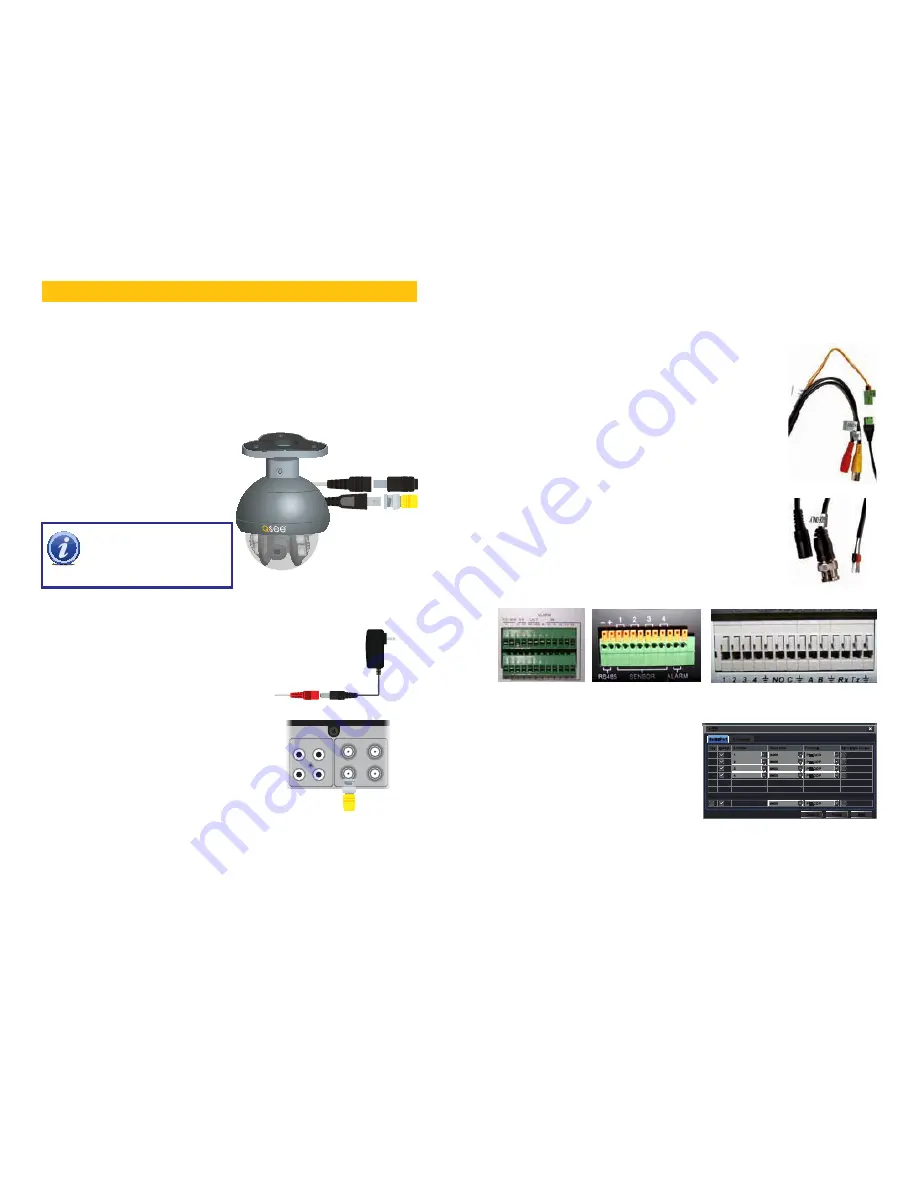
8
9
STEP 1.
Connect the BNC and power
leads from the camera to the
matching connectors on a video/
power siamese cable (Note: these
may need to be purchased separately
if your camera was not included as
part of a bundle package).
STEP 2.
Connect the power lead on the
other end of the video/power cable to
a power adapter or power distribution
panel.
Make certain that the power
supply is rated for 12 volts and
800mA to 2A.
STEP 3.
Connect the BNC connector on
that same end of the cable to a Video
In port on the back of the DVR.
You can now plug the camera’s power
adapter into a surge protector and turn it on.
To protect your investment, we STRONGLY
recommended using a surge protector that is
UL-1449 rated, for a clamping voltage of 330
or lower, a Joule rating of at least 400 and a
response time of 10 nanoseconds or less.
CONNECTING THE CAMERA
Before you can operate the camera, you must connect it to a system which can support PTZ
operations. There are three sets of connectors - power, video and the bare control wires. This
latter connection is covered on the next page. We recommend connecting the camera (at least
temporarily) to the DVR to test your settings and connections before mounting it in its final
location.
AUDIO IN
VIDEO IN
1
3
2
4
1
3
2
4
POWER AND VIDEO CONNECTION
IMPORTANT!
When connecting the
power and video cable between the camera
and the DVR, the “male” power end (red plug)
connects to the matching power lead on the
camera.
PTZ CONTROL CONNECTION
In addition to connecting the power and video leads to the camera, you must also connect
the two control wire leads to the RS485 ports in the alarm block on the back of the DVR.
These blocks can vary in layout as shown below, but the ports used by your DVR are generally
labelled “RS485”, “RS422”, “PTZ” or “P/Z”.
As seen in the picture on the upper right, the wire leads from the
camera are two different colors and are labeled. They are also pre-
installed into a block which plugs into a matching receptacle on
the extension cable. The control wire leads at the other end of the
extension cable must be inserted into the ports on the back of the
DVR. In the case of the RS485 ports being marked as positive (+)
and negative (-), the wire designated RS485A (
red tip
) is the positive
lead while the wire marked RS485B (
black tip
) is to go into the
negative port. Your camera comes with a connector PTZ blocks
either have small screws to above each port to secure the wire or
require a lock above the port to be depressed with an object like
a small screw driver in order to fully insert the wire. In the latter,
when the lock is released, an internal clamp will keep the wire firmly
secured in the port. If the wire can easily be removed from the port,
then it isn’t secure and you can experience control difficulties until it
is properly attached. Space permitting, multiple PTZ cameras may
be connected to the same ports. They will each require a different
address which is set up using the DIP switches as covered in the
previous section.
Serial Port
Serial Port
Advanced
Advanced
P.T.Z
P.T.Z
Default
Default
Apply
Apply
Exit
Exit
CH Enable Address
Baud Rate
Protocol
Simulative Cruise
1
2
3
4
CH Enable Address
Baud Rate
Protocol
Simulative Cruise
1
2
3
4
All
All
1
1
2
2
3
3
4
4
2400
2400
9600
9600
9600
9600
9600
9600
PELCOD
PELCOD
PELCOP
PELCOP
PELCOP
PELCOP
PELCOP
PELCOP
9600
9600
PELCOP
PELCOP
Some examples of PTZ blocks. One using screws (left) and two using spring-loaded locks.
To connect your camera to the DVR over a
distance, you will need to use both a video/
power cable and a pair of 24-gauge wires to
connect to the alarm block. If your camera
came as part of a package, these wires may
be included separately or as part of the video
and power cable.
Once you have made your connections, you
will need to make settings on the DVR in
order to control it. You will need to consult
your DVR’s manual for this procedure, but a
sample screen (from a Q-See QT-series DVR)
is shown on the right.










